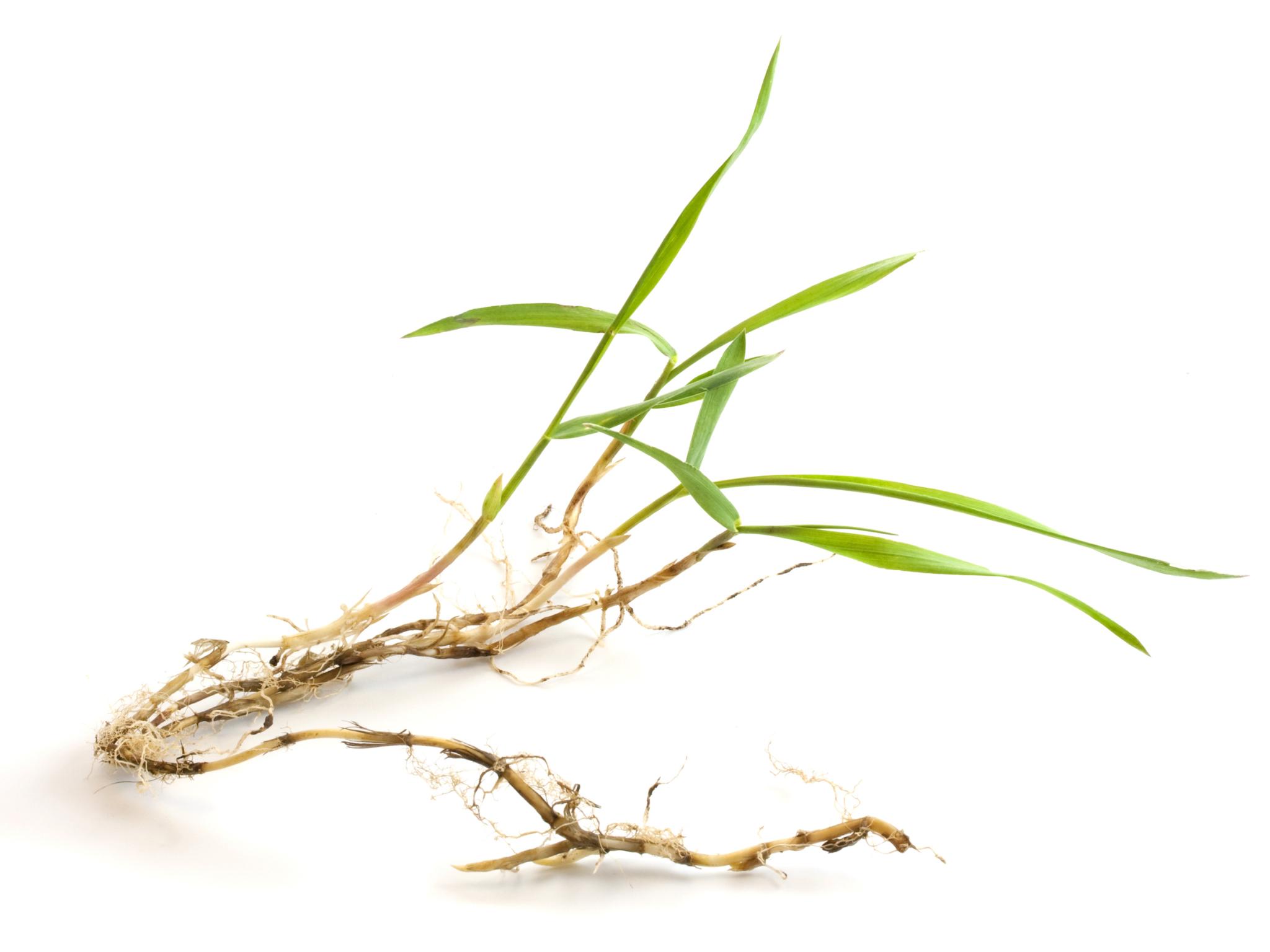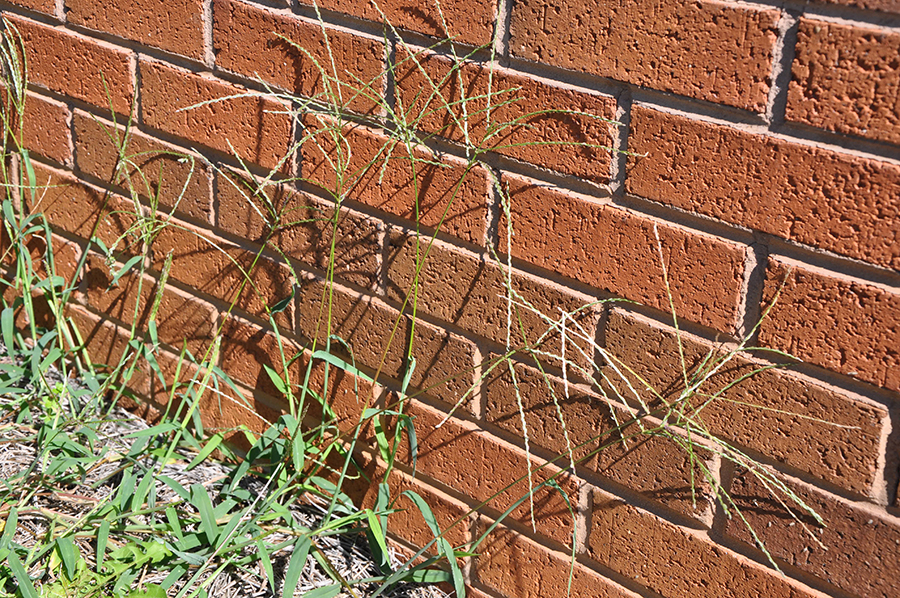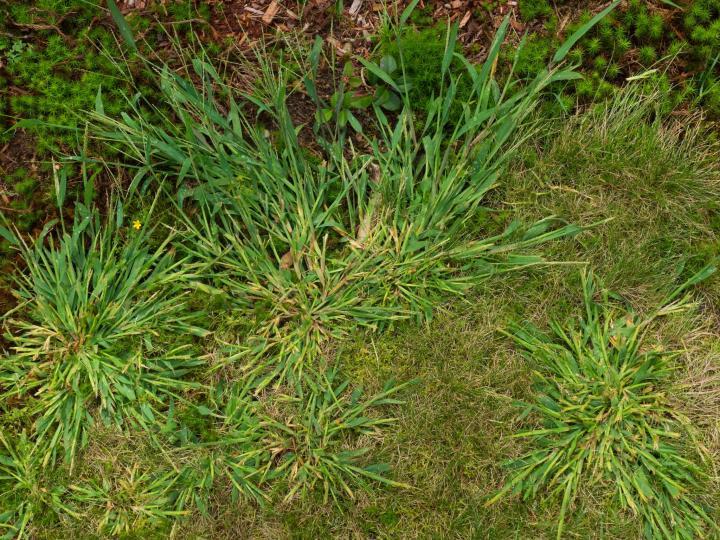Surprisingly, crabgrass is not a difficult weed to control if you know how to do it right. See our weed experts’ top five tips on how to get rid of crabgrass—plus, find out the best crabgrass killer spray that won’t hurt your lawn but also will keep crabgrass from returning.
1. Identifying Crabgrass
Crabgrasses (Digitaria spp.) are low-growing, summer annuals that spread by seed and from rooting nodes that lie on top of the soil. Undisturbed, it can grow to 2 feet tall. Typically, crabgrass germinates in the spring when soil temperatures reach 55°F for several consecutive days. Crabgrass spreads all summer long and then produces seeds in the fall.
Crabgrass thrives in poor lawns, on edges of lawn areas where soil meets the pavement, in bare spots, and in neglected areas. Think of crabgrass as nature’s red flag!
What Does Crabgrass Look Like?
When very young, crabgrass looks a bit like a small corn plant, with blades that angle out from the stem.

Mature crabgrass has a star pattern. All of the stems radiate from a single root in the center of the plant but spread along the ground with “crablike” growth. Along the prostrate stems are nodes from which roots develop. (If you pull out “crabgrass” and find long taproots, then that’s a different weed!)

By fall, the plant produces seed heads with spikes from the top of the stem. Each plant can produce thousands of seeds that remain viable in the soil for several years, which is why we say that this “annual” is a “perennial” problem.

2. Weed by Hand
If you have a limited issues with crabgrass, you can easily hand-pull the plant when it’s young, thanks to its shallow root system. Crabgrass can’t regrow if you pull up the entire crown (basal growing point) of the plant. Just water the area first to soften the soil and—to make removal even easier—use an upright weeding device.
As plants mature and the central taproot develops, however, it becomes more difficult to remove the entire growing point. Still, we do not recommend excessive tilling, as this will often bring up even more crabgrass seeds to the surface.

Uncontrolled crabgrass spreads and grows in large clumps across a lawn.
3. Use the Right Herbicide
When it comes to crabgrass, you either a) prevent it before it germinates or b) deal with it after it’s emerged. Your timing will affect what you do next.
a) BEFORE crabgrass emerges: Obviously, it’s is best to prevent crabgrass before it germinates. This means “pre-emergent” herbicide spray.
We assume you’re reading this article because it’s too late and the crabgrass has emerged, but you should address prevention next year. The most effective pre-emergent programs involve split applications: (1) Apply several weeks prior to expected crabgrass germination (often in April, in many regions) and then (2) make a second application 2 months later.
b) AFTER crabgrass appears: “Post-emergent” herbicides are the solution once crabgrass has already started to grow. This used to be a considerable challenge because many of the older post-emergent herbicides were ineffective and even unsafe. Today, however, there are effective solutions that can be sprayed directly on the crabgrass leaves WITHOUT harming your lawn.
For those interested, here is one of the best ready-to-use crabgrass post-emergents, made by Gordon’s®. It not kills crabgrass but 200 other weeds (such as Canadian Thistle and foxtail) without harming your lawn. It also comes ready-to-use with a trigger sprayer formulation to spray directly on the weeds. Once the spray is dry, both people and pets can safely and immediately re-enter the areas.
The Importance of Timing With Sprays
a) Using a pre-emergent herbicide can be tricky. Doing so requires not only advance planning but also very careful timing. It has to be applied BEFORE the seeds germinate at 55°F. How will you predict germination timing? Monitor soil temperatures and rely on your experience and phenological keys (e.g., when the forsythia bush flowers). Most garden centers sell inexpensive soil thermometers that you can use to zero-in on the right timing.
b) Because of this challenge, it’s important to be on top of post-emergent herbicide applications so that you tackle that crabgrass when it’s small!
- Do not delay spraying a post-emergent spray—it’s most effective when the weeds are immature and actively growing.
- This may require scouting for weeds. Just make it part of your daily walk around your yard and garden!
- It is essential to address this issue well before the plant seeds, or you’ll have an even bigger problem in the following year.
-
Use the right amount for the space to be effective. For example, with the Gordon’s® post-emergent crabgrass killer, you simply measure your lawn area to be sprayed. Measure length x width for square footage. Then you’ll mix just 2.5 fluid ounces with 1 gallon of water for every 400 square feet of lawn. Apply to crabgrass with the ready-to-use spray bottle or in a spray pump or hose-end sprayer.
- Using the same pre-emergents over and over can make crabgrass more resistant, so it’s important to tackle this problem with post-emergent herbicides to maximize herbicide efficacy and manage against resistance that will grow over time.
4. Prevent Seed Heads
Do not let the weeds grow seed heads! New seeds produced by weeds go into the soil and can eventually lead to more weeds. Imagine the thousands of seeds waiting in your lawn for next year!
- Certainly, mowing will help to reduce crabgrass growth but also remember that prostrate crabgrass tends to hug the ground and can still set seed when it’s as short as a 1/2 inch tall.
- A post-emergent herbicide is the best way to finish off those crabgrass weeds.
5. Grow Healthy Turf
Crabgrass loves a poor lawn. So, the best protective step for managing crabgrass is a healthy, actively growing turfgrass. Always use best cultural practices (i.e., mowing, fertilization, irrigation). Because seedling crabgrass isn’t very competitive, a more healthy lawn will crowd out new seedlings.
- Select turfgrass adapted to your location. So many people don’t choose the right grass for their conditions! As far as beating out crabgrass goes, perennial ryegrass is the best competitor. It also provides some natural insect control, as it emits a natural poison that gives some small, damaging bugs the “flu.” Ask your garden center about ryegrass or what works best in your climate.
- Feed your soil to get turfgrass off to a strong start! Supply nitrogen in early autumn and, if needed, in spring, when cool-season grasses are more competitive than these warm-season weeds. Again, speak to your local garden center.
- Mow at the highest height recommended! Mowing too low allows more light into your lawn grass, which aids more crabgrass germination. Mowing high won’t get all crabgrass, but research shows that doing so works significantly better than a low mowing height to reduce crabgrass infestations.
- Water the correct way! Light, frequent sprinkling only encourages crabgrass, which has shallow roots. Real turfgrass needs deep, infrequent irrigation to reach its roots. The ideal solution is an irrigation system that waters only when you notice that the grass seems dry. If you mow tall, you may not even need to water turfgrass in the spring, provided that you get an inch of rainfall per week.
With the major five steps above, you can take control of crabgrass. It really is one of the easiest weeds to manage (even if it’s pervasive). By following good cultural practices (such as mowing high), regularly scouting for young weeds, and using an effective post-emergent herbicide, you’ll break the cycle and prevent the spread of crabgrass!
















